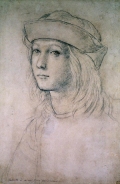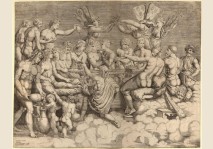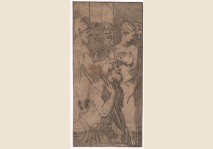Shopping Options
- Specification
-
- Print (3)
- technic
-
- Engraving (3)
- period
-
- 16th Century (3)
- School
-
- Italian (3)
- subject
- rating
- new
-
- no (3)
- Artist
-
- Agostino Veneziano (1)
- Marcantonio (1)
- Parmigianino (1)
Raphael Sanzio (1483–1520)
Raphael Sanzio (1483–1520) was an Italian master painter and architect of the Florentine school in High Renaissance, celebrated for the perfection and grace of his paintings. He was also called Raffaello Sanzio, Raffaello Santi, Raffaello da Urbino or Rafael Sanzio da Urbino.Raphael was born in Urbino.[His father, Giovanni Santi, was also a painter in the court of Urbino. His first documented work was an altarpiece for the church of San Nicola of Tolentino in Città di Castello, a town halfway between Perugia and Urbino. It was ordered in 1500 and finished in 1501 Moving to Florence when he was around 20, he was exposed to Leonardo da Vinci, and to Michelangelo, just eight years his senior, "with whom he later had a stormy and competitive relationship." (Leonardo died in 1519, one year before Raphael, but Michelangelo lived until 1564.) Raphael's time in Florence was very productive and the influences of Leonardo and Michelangelo (who were working on the Mona Lisa and David, respectively, at the time) is unmistakeable. At the end of 1508, he moved to Rome and was immediately commissioned by Julius II to paint some of the rooms at his palace at the Vatican. In 1514 he was named architect of the new St Peter's
was an Italian master painter and architect of the Florentine school in High Renaissance, celebrated for the perfection and grace of his paintings. He was also called Raffaello Sanzio, Raffaello Santi, Raffaello da Urbino or Rafael Sanzio da Urbino.Raphael was born in Urbino.[His father, Giovanni Santi, was also a painter in the court of Urbino. His first documented work was an altarpiece for the church of San Nicola of Tolentino in Città di Castello, a town halfway between Perugia and Urbino. It was ordered in 1500 and finished in 1501 Moving to Florence when he was around 20, he was exposed to Leonardo da Vinci, and to Michelangelo, just eight years his senior, "with whom he later had a stormy and competitive relationship." (Leonardo died in 1519, one year before Raphael, but Michelangelo lived until 1564.) Raphael's time in Florence was very productive and the influences of Leonardo and Michelangelo (who were working on the Mona Lisa and David, respectively, at the time) is unmistakeable. At the end of 1508, he moved to Rome and was immediately commissioned by Julius II to paint some of the rooms at his palace at the Vatican. In 1514 he was named architect of the new St Peter's
Printmaking Raphael made no prints himself, but entered into a collaboration with Marcantonio Raimondi to produce engravings to Raphael's designs, which created many of the most famous Italian prints of the century, and was important in the rise of the reproductive print. A total of about fifty prints were made; some were copies of Raphael's paintings, but other designs were apparently created only to be made into prints. Raphael made preparatory drawings, many of which survive, for Raimondi to translate into engraving. The two most famous original prints to result from the collaboration were Lucretia and The Massacre of the Innocents. Outside Italy, reproductive prints by Raimondi and others were the main way that Raphael's art was experienced.
-
 WEDDING OF PELEUS AND THETIS - 1545Learn More$1,500.00
WEDDING OF PELEUS AND THETIS - 1545Learn More$1,500.00 -
 Blinding of Elmyas - A.V. 1516Learn More$400.00
Blinding of Elmyas - A.V. 1516Learn More$400.00 -








 Facebook
Facebook Twitter
Twitter Subscribe us
Subscribe us Flickr
Flickr




